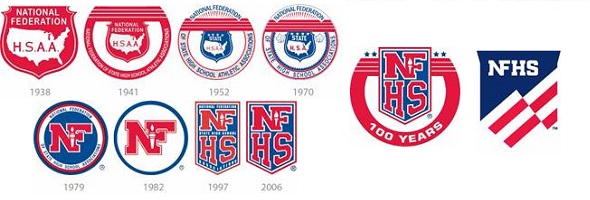
NFHS Introduces Updated Logo
July 17, 2019
Special from NFHS
As the National Federation of State High School Associations (NFHS) heads into the next 100 years of leading high school sports and other activity programs nationwide, it will be doing so with a new logo.
 The new logo was unveiled to the membership earlier this month at the close of the NFHS Centennial Celebration. The NFHS and its 51-member state high school associations celebrated the organization’s accomplishments at the 100th Annual Meeting at the JW Marriott in downtown Indianapolis.
The new logo was unveiled to the membership earlier this month at the close of the NFHS Centennial Celebration. The NFHS and its 51-member state high school associations celebrated the organization’s accomplishments at the 100th Annual Meeting at the JW Marriott in downtown Indianapolis.
The organization will continue to be branded as the NFHS in the new logo, and the N and F are connected as has been the case since 1979. However, the entire acronym is together on one line as opposed to the previous logo with the NF and HS on separate lines. While red and blue will continue to be the predominant colors, the new logo mixes white with red and blue to suggest a flag waving in the wind. The direction of the flag is pointing upward to symbolize forward-thinking and advancement.
The new design maintains a resemblance to the shield that has been a part of the NFHS logo since 1997. However, the logo is flared at the top, and the bottom of the logo does not have definitive borders, which suggests the organization has moved past its first 100 years and is expanding its reach as the national leadership organization for high school sports and performing arts programs in the United States.
While the organization’s logo from 1952 had four stars to signify the four charter members of the NFHS, the four stripes within the new logo represent the four homes of the organization during the first 100 years.
“We wanted to retain NFHS as the central component of the new logo because the organization’s national presence has continued to spiral upward in the 22 years since the NFHS acronym was adopted,” said Dr. Karissa Niehoff, NFHS executive director. “However, as we celebrated our first 100 years, we felt it was important to establish a new look that would signify our ever-increasing role as the national leader in high school sports and performing arts programs.”
Counting the Centennial logo that was used during the 2018-19 school year, the new logo will be 10th used by the organization since the first one was adopted in the 1930s. The new logo was created by Section 127, an Indianapolis-based design company.
The NFHS was started in 1920 and had offices in Chicago until 1971, when it moved to Elgin, Illinois. The organization moved to Kansas City, Missouri, in 1979, and then in 2000 to Indianapolis, where it remains today.
The Michigan High School Athletic Association is a member of the NFHS, and Michigan is one of the four founding states of the national association.

Baseball's Record-Setting Spectatorship Headlines MHSAA's 2024-25 Attendance Report
By
Geoff Kimmerly
MHSAA.com senior editor
December 12, 2025
An overall attendance record in baseball and several more all-time bests for specific rounds of other sports’ postseason tournaments kept attendance at Michigan High School Athletic Association events near 1.4 million spectators for the third-straight school year in 2024-25.
Total, MHSAA Tournament events drew 1,397,574 spectators at competitions for which admission is charged – which counts all MHSAA-sponsored sports except golf, skiing and tennis, as single tickets are not sold for those postseason events. The total of just under 1.4 million spectators is a decrease of 3.6 percent from 2023-24, but still the third-highest overall attendance over the last eight school years.
Attendance at girls events for 2024-25 was 453,320 fans, a 3.9-percent decrease from the 2023-24 record-setting total but the second-highest over the last eight years.
The boys attendance of 944,254 was 3.4 percent fewer than the previous year. However, baseball set an overall tournament record with 65,150 spectators, with records as well of 38,086 at the District level and 7,517 attending Quarterfinals. Every round of the baseball postseason saw an increase from the previous year.
Overall attendance totals for the ice hockey, team wrestling, gymnastics, boys soccer and girls swimming & diving postseason tournaments also were up from 2023-24. Ice hockey set records at its Semifinals (7,758 spectators) and Finals (7,857), boys soccer at the District level (18,219) and team wrestling also at its Finals (11,604).
Football remains the most-attended MHSAA Tournament sport and drew 361,139 spectators for its playoff series – a decrease of just above a half-percent from the previous year but with the highest Finals turnout (44,535) since 2019-20. Boys basketball attendance remained second across all seasons at 251,668 spectators, followed by girls basketball at 145,313 and girls volleyball at 110,927.
Track & field (41,418 spectators) and softball (47,763) posted their second-highest attendances on record after setting records during the 2023-24 school year.
The MHSAA is a private, not-for-profit corporation of voluntary membership by more than 1,500 public and private senior high schools and junior high/middle schools which exists to develop common rules for athletic eligibility and competition. No government funds or tax dollars support the MHSAA, which was the first such association nationally to not accept membership dues or tournament entry fees from schools. Member schools which enforce these rules are permitted to participate in MHSAA tournaments, which attract more than 1.4 million spectators each year.

